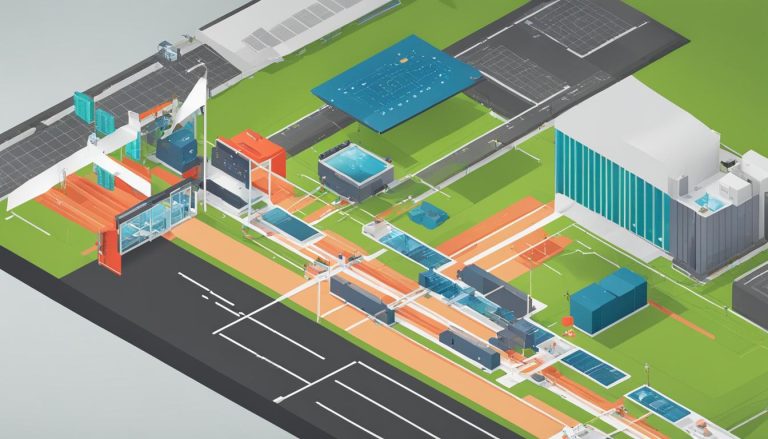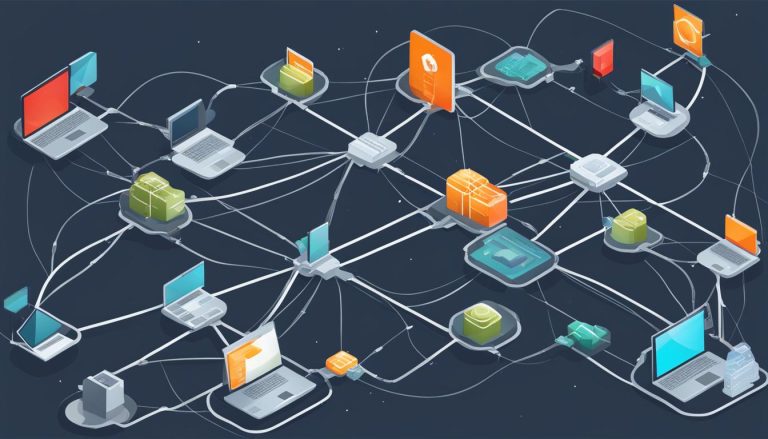Quantum teleportation is a fascinating concept in the field of quantum physics that involves transferring quantum information from one location to another, without physically moving the information itself. It relies on the phenomenon of quantum entanglement, which connects particles in a way that their states become correlated. Researchers from Google Quantum AI and Stanford University have made significant strides in understanding quantum teleportation and its implications for quantum computing. They have observed a “measurement-induced phase transition” in a quantum system with up to 70 qubits, as well as a unique form of quantum teleportation that could lead to advancements in the field.
Key Takeaways:
- Quantum teleportation allows for the transfer of quantum information without physically moving the information itself.
- It relies on the phenomenon of quantum entanglement, which connects particles in a correlated way.
- Researchers from Google Quantum AI and Stanford University have made significant advancements in understanding quantum teleportation and its implications for quantum computing.
- They have observed a “measurement-induced phase transition” in a quantum system with up to 70 qubits.
- A unique form of quantum teleportation has been discovered, which could lead to further advancements in the field.
The Role of Measurements in Quantum Systems
In the realm of quantum mechanics, measurements play a crucial role in understanding the behavior of quantum systems. When a quantum system is measured, its “quantumness” is affected, leading to a transition between the quantum and classical worlds. This interplay between measurements and interactions in a quantum system has been the focus of research by scientists at Google Quantum AI and Stanford University.
Measurements are fundamental in quantum physics as they provide information about the properties and characteristics of quantum systems. In the context of quantum teleportation, measurements are used to extract information from one quantum system and transfer it to another, without physically moving the information itself. This process relies on the entanglement of particles, which allows for the correlation of their states.
Quantum systems are characterized by the presence of qubits, which are the fundamental units of quantum data. Measurements on qubits can result in different outcomes, depending on the properties being measured and the interactions within the system. These outcomes can reveal valuable information about the quantum state of the system and enable the manipulation and transfer of quantum information.
Measurement-Induced Phase Transitions and Quantum Teleportation
The researchers at Google Quantum AI and Stanford University have made groundbreaking discoveries related to measurement-induced phase transitions and quantum teleportation. By exploring the crossover between two distinct phases in a system of up to 70 qubits, they have observed the effects of measurements on the distribution and structure of quantum information. This study has also revealed a unique form of quantum teleportation that occurs as a result of these measurements. These findings have the potential to advance the field of quantum computing and inspire new techniques for information transfer.
The phenomenon of measurement-induced phase transitions in quantum systems is of great interest to scientists studying quantum teleportation. By carefully manipulating the qubits and observing the changes in their quantum states, researchers can understand how measurements affect the behavior of these systems. This knowledge is crucial for developing more efficient and reliable quantum teleportation protocols.
In the observed measurement-induced phase transition, the researchers noticed a sudden change in the properties of the quantum system when certain measurements were performed. This phase transition marks a shift from one quantum state to another, often resulting in the creation of entangled qubits that form the basis of quantum teleportation. These entangled qubits can then be used to transfer quantum information from one location to another, enabling secure and efficient communication.
Table: Summary of Measurement-Induced Phase Transition and Quantum Teleportation
| Discovery | Effects | Implications |
|---|---|---|
| Measurement-induced phase transition in a system of up to 70 qubits | Alteration of quantum information distribution and structure | Potential advancements in quantum computing and information transfer techniques |
| Unique form of quantum teleportation as a result of measurements | Creation of entangled qubits for secure and efficient information transfer | Promising applications in quantum communication and encryption |
The study of measurement-induced phase transitions and their relationship to quantum teleportation opens up exciting possibilities for the future of quantum information processing. As researchers delve deeper into the intricacies of these phenomena, we can expect to witness even more significant breakthroughs in the field. Quantum teleportation, with its potential for secure and instantaneous information transfer, holds immense promise for revolutionizing various industries and paving the way for the next generation of advanced technologies.
Advancements in Teleportation Speed and the Quantum Internet
The development of quantum teleportation has not only raised exciting possibilities for quantum computing and quantum communication but also prompted researchers to push the boundaries of speed and distance in this field. Recent advancements by the University of Electronic Science and Technology of China have propelled us closer to achieving efficient and far-reaching quantum teleportation. Using innovative technology, they have achieved a new speed record of 7.1 qubits per second, overcoming previous limitations. This breakthrough signifies a major step towards the establishment of a robust and extensive quantum internet.
Quantum teleportation relies on the process of quantum entanglement, where particles become interconnected in a way that their states are correlated regardless of distance. In the context of quantum communication, this phenomenon enables the transfer of quantum information over long distances. By harnessing the power of quantum entanglement and combining it with classical communication methods, researchers are paving the way for global-scale quantum communication applications.
To demonstrate the feasibility of long-distance quantum teleportation, researchers from the University of Science and Technology of China and Tsinghua University have successfully teleported information between photons over a free space distance of 16 km. This achievement has significant implications for space-based quantum teleportation experiments, including those involving ground stations and satellites. It brings us one step closer to realizing the potential of quantum communication over vast distances.
| Advancements in Teleportation Speed and the Quantum Internet | ||
|---|---|---|
| Initial Speed Limit | Previous Speed Record | New Speed Record |
| Limited to a few qubits per second | 6.6 qubits per second | 7.1 qubits per second |
With these advancements in teleportation speed, the creation of a quantum internet is becoming increasingly tangible. A quantum internet would revolutionize the way we connect and share information, enabling secure and rapid communication that is impervious to traditional hacking methods. It holds the potential to transform industries such as finance, healthcare, and telecommunications, empowering us with unprecedented capabilities in the digital world.
The possibilities brought forth by advancements in teleportation speed and the establishment of a quantum internet are truly awe-inspiring. The combined efforts of researchers worldwide continue to push the boundaries of what was once deemed impossible, opening up a new era of quantum communication and paving the way for a future defined by the remarkable power of quantum teleportation.
Overcoming Distance Limitations in Quantum Teleportation
In previous experiments, the distance of quantum teleportation was limited to a few hundred meters due to the need for fiber channels to maintain the integrity of the quantum state. However, researchers from the University of Science and Technology of China and Tsinghua University have successfully teleported information between photons over a free space distance of 16 km. This achievement demonstrates the feasibility of space-based quantum teleportation and opens up possibilities for experiments between ground stations and satellites, as well as two ground stations with a satellite acting as a relay. It brings us one step closer to realizing the potential of quantum communication over long distances.
This breakthrough in overcoming distance limitations in quantum teleportation was made possible by harnessing the properties of photons and leveraging the capabilities of free space channels. By utilizing advanced equipment and precise control systems, the researchers were able to maintain the quantum state of the photons over the 16 km distance. This achievement is a significant milestone in the development of practical quantum communication systems that can operate over long distances without the need for physical infrastructure, such as fiber optic cables.
Space-based quantum teleportation has several advantages over traditional methods that rely on fiber channels. In addition to enabling long-distance transmission, free space channels provide a more flexible and scalable approach to quantum communication. Satellites can serve as relay stations for transferring quantum information between ground-based stations, allowing for global-scale communication networks. This technology has the potential to revolutionize secure communication, quantum cryptography, and other applications that require the transmission of sensitive information over vast distances.
In conclusion, the successful teleportation of information between photons over a free space distance of 16 km represents a major breakthrough in quantum communication. By overcoming the distance limitations of previous experiments, researchers have paved the way for the practical implementation of space-based quantum teleportation systems. This achievement brings us closer to the realization of a global quantum communication network, with applications ranging from secure data transmission to quantum computing. As further advancements are made in the field, the potential of quantum teleportation to revolutionize the way we communicate and process information becomes increasingly evident.
Overcoming Technical Challenges in Quantum Teleportation
Quantum teleportation, a revolutionary concept in the field of quantum physics, presents unique technical challenges that researchers have been actively addressing. As we strive to enhance the efficiency and accuracy of quantum teleportation systems, the field of quantum optics plays a crucial role in overcoming these hurdles.
One of the key technical challenges in quantum teleportation is stabilizing photon paths and polarization. By carefully controlling and manipulating these properties, researchers can ensure the successful transfer of quantum information. Additionally, the use of high-performance photon sensors, such as superconducting nanowire single-photon detectors, contributes to the improvement of quantum state analysis and the overall reliability of quantum teleportation systems.
Efforts to overcome these technical challenges pave the way for practical implementations of quantum communication, a key application of quantum teleportation. Quantum communication enables secure transmission of information, leveraging the unique properties of quantum mechanics. With advancements in photon sensors and quantum optics, we are one step closer to realizing the full potential of quantum communication in various industries and sectors.
Advancements in Quantum Optics and Photon Sensors
“Quantum optics plays a crucial role in overcoming technical challenges in quantum teleportation.”
Quantum optics focuses on the interactions between light and matter at the quantum level, providing insights and techniques to manipulate and control quantum states of photons. This field has seen remarkable advancements in recent years, leading to improvements in quantum teleportation capabilities. By harnessing the principles of entanglement and superposition, researchers have been able to achieve higher fidelity and longer-distance teleportation.
| Advancements in Quantum Optics and Photon Sensors | Benefits |
|---|---|
| Stabilization of photon paths and polarization | Ensures successful transfer of quantum information |
| Use of high-performance photon sensors | Improves quantum state analysis and reliability |
| Advancements in quantum optics | Enables higher fidelity and longer-distance teleportation |
Researchers continue to push the boundaries of quantum optics and photon sensor technologies, seeking innovative solutions that will further enhance the capabilities of quantum teleportation and quantum communication. With ongoing advancements, the practical implementation of a quantum internet infrastructure becomes increasingly feasible, opening up new horizons for secure and efficient information transfer in the quantum realm.
Conclusion
Quantum teleportation is a captivating concept in the field of quantum physics that has the potential to revolutionize various applications, including quantum computing and quantum communication. I have been intrigued by the significant strides researchers have made in understanding the interplay between measurements, interactions, and entanglement in quantum systems.
The advancements in teleportation speed and the overcoming of technical challenges bring us closer to the realization of a quantum internet, capable of transferring quantum information over long distances. With further research and development, the practical applications of quantum teleportation are expected to expand and transform various industries.
As we continue to explore the mysteries of quantum teleportation, the possibilities for future applications are vast. Imagine a world where we can securely transmit and process quantum information, leading to advancements in fields such as cryptography, medicine, and weather forecasting. The potential for quantum computing to solve complex problems that are currently beyond our reach is truly exciting.
While there is still much to discover and refine in the realm of quantum teleportation, I am confident that its continued exploration will unlock new frontiers in technology and shape the future of information processing. The road ahead may be challenging, but the possibilities it holds are endless.
FAQ
What is quantum teleportation?
Quantum teleportation is the process of transferring quantum information from one location to another without physically moving the information itself.
How does quantum teleportation work?
Quantum teleportation relies on the phenomenon of quantum entanglement, which connects particles in a way that their states become correlated. By manipulating the entangled particles, the quantum information can be transferred to another location.
What is the role of measurements in quantum systems?
Measurements play a crucial role in understanding the behavior of quantum systems. When a quantum system is measured, its “quantumness” is affected, leading to a transition between the quantum and classical worlds.
What are measurement-induced phase transitions?
Measurement-induced phase transitions refer to the effects of measurements on the distribution and structure of quantum information in a system. These transitions can result in the emergence of new phases of quantum information.
What advancements have been made in quantum teleportation speed?
Researchers have achieved a new speed record of 7.1 qubits per second in quantum teleportation. This breakthrough brings us closer to the development of an efficient and far-reaching quantum internet.
How has the distance limitation of quantum teleportation been overcome?
Researchers have successfully teleported information between photons over a free space distance of 16 km. This achievement demonstrates the feasibility of space-based quantum teleportation and opens up possibilities for long-distance quantum communication.
What are some of the technical challenges in quantum teleportation?
Technical challenges include stabilizing photon paths and polarization, as well as using high-performance photon sensors such as superconducting nanowire single-photon detectors.
What are the potential applications of quantum teleportation?
Quantum teleportation has the potential to revolutionize various applications, including quantum computing and quantum communication. It could enable the development of a quantum internet capable of transferring quantum information over long distances.
Jana is a public relations specialist and writes about all kinds of software products that make our life easier.


